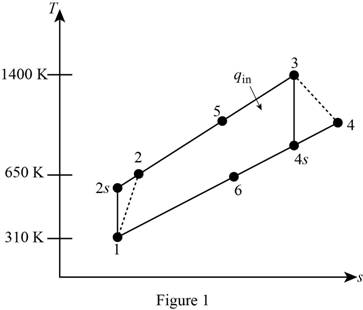
The exergy destruction associated with each process of the Brayton cycle and the exergy of the exhaust gases at the exit of the regenerator.
Answer to Problem 146P
The exergy destruction associated with process 1-2 of the given Brayton cycle is
The exergy destruction associated with process 3-4 of the given Brayton cycle is
The exergy destruction associated with regeneration process of the given Brayton cycle is
The exergy destruction associated with process 5-3 of the given Brayton cycle is
The exergy destruction associated with process 6-1 of the given Brayton cycle is
The exergy of the exhaust gases at the exit of the regenerator is
Explanation of Solution
Show the regenerative Brayton cycle with air as the working fluid, on

For the given regenerative Brayton cycle with air as the working fluid, let
Write the expression of pressure ratio for the regenerative Brayton cycle
Write the pressure ratio and pressure relation for the process 3-4.
Write the expression of efficiency of the turbine
Write the expression of heat added due to regeneration
Here, the effectiveness of the regenerator is
Write the expression of net work output of the regenerative Brayton cycle
Here, the work output by the turbine is
Write the expression of heat input to the regenerative Brayton cycle
Write the expression of heat rejected by the regenerative Brayton cycle
Write the expression of specific enthalpy at state 6
Write the specific enthalpy relation for the regenerator.
Write the expression of exergy destruction associated with the process 1-2 of the given Brayton cycle
Here, the temperature of the surroundings is
Write the expression of exergy destruction associated with the process 3-4 of the given Brayton cycle
Here, entropy of air at state 3 as a function of temperature is
Write the expression of exergy destruction associated with the regeneration process of the given Brayton cycle
Here, entropy of air at state 5 as a function of temperature alone is
Write the expression of exergy destruction associated with the process 5-3 of the given Brayton cycle
Here, the temperature of the heat source is
Write the expression of exergy destruction associated with the process 6-1 of the given Brayton cycle
Here, the temperature of the sink is
Write the expression of stream exergy at the exit of the regenerator (state 6)
Here, the specific enthalpy of the surroundings is
Write the expression of change entropy for the exit of the regenerator
Here, entropy of air at the surroundings as a function of temperature alone is
Conclusion:
Refer Table A-17, “Ideal gas properties of air”, obtain the properties of air at 310 K
Substitute 900 kPa for
Substitute
Refer Table A-17, “Ideal gas properties of air”, obtain the properties of air at 50.06
Rearrange Equation (III) and substitute
Substitute 0.80 for
Substitute
Substitute
Substitute
Substitute 310.24
Rearrange Equation (IX), and substitute 659.84
Refer Table A-17, “Ideal gas properties of air”, obtain the properties of air at 310 K
Substitute 300 K for
Thus, the exergy destruction associated with process 1-2 of the given Brayton cycle is
Substitute 300 K for
Thus, the exergy destruction associated with process 3-4 of the given Brayton cycle is
Substitute 300 K for
Thus, the exergy destruction associated with regeneration process of the given Brayton cycle is
Substitute 300 K for
Thus, the exergy destruction associated with process 5-3 of the given Brayton cycle is
Substitute 300 K for
Thus, the exergy destruction associated with process 6-1 of the given Brayton cycle is
Refer Table A-17, “Ideal gas properties of air”, obtain the properties of air at 300 K
Substitute
Substitute
Thus, the exergy of the exhaust gases at the exit of the regenerator is
Want to see more full solutions like this?
Chapter 9 Solutions
Thermodynamics: An Engineering Approach
- HW12 A multiple-disc clutch has five plates having four pairs of active friction surfaces. If the intensity of pressure is not to exceed 0.127 N/mm², find the power transmitted at 500 r.p.m. The outer and inner radii of friction surfaces are 125 mm and 75 mm respectively. Assume uniform wear and take the coefficient of friction = 0.3.arrow_forwardThe sketch below gives some details of the human heart at rest. What is the total power requirement (work/time) for an artificial heart pump if we use a safety factor of 5 to allow for inefficiencies, the need to operate the heart under stress, etc.? Assume blood has the properties of water. p pressure above atmosphere blood going to the lungs for a fresh charge of oxygen p = 2.9 kPa 25v pulmonary artery d = 25mm fresh oxygenated blood from the lungs p = 1.0 kPa vena cava d=30mm right auricle pulmonary vein, d = 28mm aorta, d=20mm spent blood returning from left auricle the body p = 0.66 kPa right left ventricle ventricle blood to feed the body, p 13 kPa normal blood flow = 90 ml/sarrow_forward4- A horizontal Venturi meter is used to measure the flow rate of water through the piping system of 20 cm I.D, where the diameter of throat in the meter is d₂ = 10 cm. The pressure at inlet is 17.658 N/cm2 gauge and the vacuum pressure of 35 cm Hg at throat. Find the discharge of water. Take Cd = 0.98.arrow_forward
 Elements Of ElectromagneticsMechanical EngineeringISBN:9780190698614Author:Sadiku, Matthew N. O.Publisher:Oxford University Press
Elements Of ElectromagneticsMechanical EngineeringISBN:9780190698614Author:Sadiku, Matthew N. O.Publisher:Oxford University Press Mechanics of Materials (10th Edition)Mechanical EngineeringISBN:9780134319650Author:Russell C. HibbelerPublisher:PEARSON
Mechanics of Materials (10th Edition)Mechanical EngineeringISBN:9780134319650Author:Russell C. HibbelerPublisher:PEARSON Thermodynamics: An Engineering ApproachMechanical EngineeringISBN:9781259822674Author:Yunus A. Cengel Dr., Michael A. BolesPublisher:McGraw-Hill Education
Thermodynamics: An Engineering ApproachMechanical EngineeringISBN:9781259822674Author:Yunus A. Cengel Dr., Michael A. BolesPublisher:McGraw-Hill Education Control Systems EngineeringMechanical EngineeringISBN:9781118170519Author:Norman S. NisePublisher:WILEY
Control Systems EngineeringMechanical EngineeringISBN:9781118170519Author:Norman S. NisePublisher:WILEY Mechanics of Materials (MindTap Course List)Mechanical EngineeringISBN:9781337093347Author:Barry J. Goodno, James M. GerePublisher:Cengage Learning
Mechanics of Materials (MindTap Course List)Mechanical EngineeringISBN:9781337093347Author:Barry J. Goodno, James M. GerePublisher:Cengage Learning Engineering Mechanics: StaticsMechanical EngineeringISBN:9781118807330Author:James L. Meriam, L. G. Kraige, J. N. BoltonPublisher:WILEY
Engineering Mechanics: StaticsMechanical EngineeringISBN:9781118807330Author:James L. Meriam, L. G. Kraige, J. N. BoltonPublisher:WILEY





